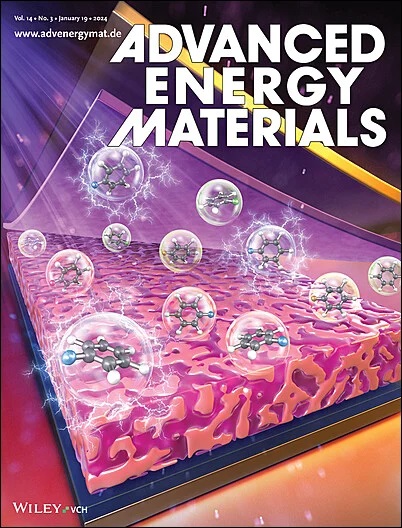完全熔融的非富勒烯受体实现了高效的免后处理有机光伏电池
IF 24.4
1区 材料科学
Q1 CHEMISTRY, PHYSICAL
引用次数: 0
摘要
通过调节组成材料的聚集结构和成膜动力学,可以显著提高有机光伏电池(OPV)的光伏性能。然而,许多调节策略,包括使用添加剂和退火,都需要复杂的制造工艺和额外的投资,这给 OPV 电池的产业化带来了挑战。在这项工作中,设计并合成了一种完全融合的非富勒烯受体 GS-20,它具有很强的聚集特性。在基于 PBQx-TF:eC9-2Cl 的电池中加入 GS-20 作为第三组分,可加速 eC9-2Cl 的聚集,并通过促进薄膜沉积来改善分子堆积。未经任何后处理而制造的三元 OPV 电池的 VOC 高达 0.890 V,最大 PCE 为 19.0%。此外,利用叶片镀膜法制造的无后处理 OPV 模块获得了令人满意的 13.5% PCE,这表明大规模制备具有极佳的可行性。这项工作通过分子设计和三元策略实现了高效的无后处理 OPV 电池,促进了 OPV 技术的产业化。本文章由计算机程序翻译,如有差异,请以英文原文为准。
Completely Fused Non‐Fullerene Acceptor Enables Efficient Postprocessing‐Free Organic Photovoltaics Cells
The photovoltaic performance of organic photovoltaic (OPV) cells can be significantly improved by regulating the aggregation structure and film formation kinetics of the constituent materials. However, many regulation strategies, including the use of additives and annealing, require complex fabrication processes and additional investments, which poses challenges for the industrialization of OPV cells. In this work, a completely fused non‐fullerene acceptor, GS‐20 is designed and synthesized, with strong aggregation properties. The incorporation of GS‐20 as a third component into the PBQx‐TF:eC9‐2Cl‐based cell accelerates aggregation of eC9‐2Cl and improves molecular stacking by promoting film deposition. The as‐cast ternary OPV cells fabricated without any post‐treatments exhibited a high V OC of 0.890 V and a maximum PCE of 19.0%. Moreover, a postprocessing‐free OPV module is fabricated using the blade coating method and obtains a satisfactory PCE of 13.5%, indicating excellent feasibility for large‐scale preparation. This work realizes an efficient postprocessing‐free OPV cell through molecular design and ternary strategy, facilitating the industrialization of OPV technology.
求助全文
通过发布文献求助,成功后即可免费获取论文全文。
去求助
来源期刊

Advanced Energy Materials
CHEMISTRY, PHYSICAL-ENERGY & FUELS
CiteScore
41.90
自引率
4.00%
发文量
889
审稿时长
1.4 months
期刊介绍:
Established in 2011, Advanced Energy Materials is an international, interdisciplinary, English-language journal that focuses on materials used in energy harvesting, conversion, and storage. It is regarded as a top-quality journal alongside Advanced Materials, Advanced Functional Materials, and Small.
With a 2022 Impact Factor of 27.8, Advanced Energy Materials is considered a prime source for the best energy-related research. The journal covers a wide range of topics in energy-related research, including organic and inorganic photovoltaics, batteries and supercapacitors, fuel cells, hydrogen generation and storage, thermoelectrics, water splitting and photocatalysis, solar fuels and thermosolar power, magnetocalorics, and piezoelectronics.
The readership of Advanced Energy Materials includes materials scientists, chemists, physicists, and engineers in both academia and industry. The journal is indexed in various databases and collections, such as Advanced Technologies & Aerospace Database, FIZ Karlsruhe, INSPEC (IET), Science Citation Index Expanded, Technology Collection, and Web of Science, among others.
 求助内容:
求助内容: 应助结果提醒方式:
应助结果提醒方式:


